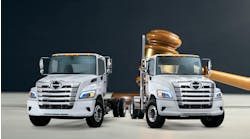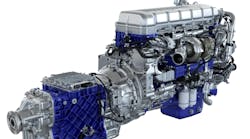One of the more elegant advances in diesel technology enabled by the latest generation of "intelligent" drivetrains today is engine "downspeeding."
The concept isn't new: Engineers working on the earliest diesel designs understood that slower turning engines naturally consumed less fuel. But, given the limits of mechanically-controlled engine technology and the very real demands for high horsepower and low-end torque, a sort of engineering compromise was reached that gave trucks the best of both worlds in terms of using horsepower and torque efficiently.
Until very recently, most heavy-duty Diesel engines ran around 1,300 RPMs at highway cruise speeds (in the neighborhood of 65 mph). This “sweet spot” gave trucks a good intersection of torque and horsepower that enabled lots of low-end grunt to get a rig moving while delivering ample horsepower to cruise and pass in highway applications. The problem was that there was no way to adjust those torque and horsepower settings on the fly to deliver higher fuel economy without severely compromising overall vehicle performance. The advent of “intelligent,” fully-integrated drivetrains today have changed all that with their ability to monitor changing road and driving conditions and instantly adjust drivetrain performance to deal with them.
Efforts pioneered by Volvo, as well as Eaton, have seen a new generation of engines that indicate around 1,100 RPMs at cruise speeds on the tachometer. Although it doesn't sound like a lot, a recent study commissioned by the North American Council for Freight Efficiency (NACFE) found that a reduction of 200 RPMs could boost fuel fuel economy in heavy-duty, long-haul applications by as much as 3 percent. NACFE calculated that even with today's low pump prices, downspeeding technology alone could deliver $1,000 a year in fuel savings directly to a fleet's bottom line.
Downspeeding technology couples today's lower-revving, high-torque, electronically-controlled engines with high-speed rear axle components. These combined technologies are what allow trucks to maintain highway speeds at lower engine RPMs. The trade-off, of course, is a corresponding rise in low-end torque, which can severely strain conventional drivetrain components. OEMs and component suppliers address this problem by taking advantage of onboard electronic control modules to tweak both the engine's fuel mapping and an automated manual transmission's shifting patterns at lower speeds as well as spec'ing more robust axles gears and other driveline components to handle increased torque loads. And all this happens seamlessly without any driver input beyond the usual throttle adjustments or braking.
Currently, NACFE estimates only about 25 percent of new heavy-duty trucks sold use downspeeding engine technology. And there are some trade-offs: The heavier drivetrain components downspeed engines require can drive acquisition costs up by as much as $1,500, in addition to the upcharge for an integrated powertrain package. And because the trucks are, in reality, niche-engineered specifically for long-haul applications, fears that resell values will be affected are common. Concerns about driver acceptance of the new technology and possible recruiting and retention problems are common as well.
On the other hand, NACFE found that drivers reported smoother, quieter rides at highway speeds in trucks with downspeeding technology. They also liked the more responsive take-off power provided by the increased low-end engine torque.
Integrated drivetrains have been a key component in taking Class 8 fuel economy to a level unheard of just a decade ago. Taken as a whole, it seems likely that downspeed engines will become more accepted and prevalent in the near future. Dana engineers recently announced that given the rapid advances in powertrain electronics today, a new, 900-rpm cruise target is entirely possible in the near future -- a development that could soon tack on an additional 3 percent fuel economy boost for trucks outfitted with these highly-specialized drivetrains.


